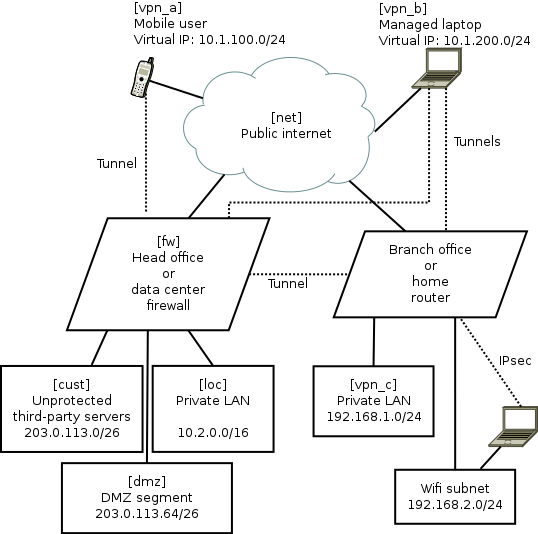Antoine Beaupr : how to audit for open services with iproute2
The computer world has a tendency of reinventing the wheel once in a
while. I am not a fan of that process, but sometimes I just have to
bite the bullet and adapt to change. This post explains how I adapted
to one particular change: the
netstat to sockstat transition.
I used to do this to show which processes where listening on which
port on a server:
netstat -anpe
-a), not resolve hostnames (-n, because it's slow), show
processes attached to the socket (-p) with extra info like the user
(-e). This still works, but sometimes fail to find the actual
process hooked to the port. Plus, it lists a whole bunch of UNIX
sockets and non-listening sockets, which are generally irrelevant
for such an audit.
What I really wanted to use was really something like:
netstat -pleunt sort
-l) and network sockets, specifically UDP (-u) and TCP
(-t).
But enough with the legacy, let's try the brave new world of sockstat
which has the unfortunate acronym ss.
The equivalent sockstat command to the above is:
ss -pleuntO
-O flag otherwise ss
does that confusing thing where it splits the output on multiple
lines. But I actually use:
ss -plunt0
-e as the information it gives (cgroup, fd
number, etc) is not much more useful than what's already provided with
-p (service and UID).
All of the above also show sockets that are not actually a concern
because they only listen on localhost. Those one should be filtered
out. So now we embark into that wild filtering ride.
This is going to list all open sockets and show the port number and
service:
ss -pluntO --no-header sed 's/^\([a-z]*\) *[A-Z]* *[0-9]* [0-9]* *[0-9]* */\1/' sed 's/^[^:]*:\(:\]:\)\?//;s/\([0-9]*\) *[^ ]*/\1\t/;s/,fd=[0-9]*//' sort -gu
anarcat@angela:~$ sudo ss -pluntO --no-header sed 's/^\([a-z]*\) *[A-Z]* *[0-9]* [0-9]* *[0-9]* */\1/' sed 's/^[^:]*:\(:\]:\)\?//;s/\([0-9]*\) *[^ ]*/\1\t/;s/,fd=[0-9]*//' sort -gu
[::]:* users:(("unbound",pid=1864))
22 users:(("sshd",pid=1830))
25 users:(("master",pid=3150))
53 users:(("unbound",pid=1864))
323 users:(("chronyd",pid=1876))
500 users:(("charon",pid=2817))
631 users:(("cups-browsed",pid=2744))
2628 users:(("dictd",pid=2825))
4001 users:(("emacs",pid=3578))
4500 users:(("charon",pid=2817))
5353 users:(("avahi-daemon",pid=1423))
6600 users:(("systemd",pid=3461))
8384 users:(("syncthing",pid=232169))
9050 users:(("tor",pid=2857))
21027 users:(("syncthing",pid=232169))
22000 users:(("syncthing",pid=232169))
33231 users:(("syncthing",pid=232169))
34953 users:(("syncthing",pid=232169))
35770 users:(("syncthing",pid=232169))
44944 users:(("syncthing",pid=232169))
47337 users:(("syncthing",pid=232169))
48903 users:(("mosh-client",pid=234126))
52774 users:(("syncthing",pid=232169))
52938 users:(("avahi-daemon",pid=1423))
54029 users:(("avahi-daemon",pid=1423))
anarcat@angela:~$
ss -pluntO --no-header \
sed 's/^\([a-z]*\) *[A-Z]* *[0-9]* [0-9]* *[0-9]* */\1/;s/^tcp//;s/^udp//' \
grep -v -e '^\[fe80::' -e '^127.0.0.1' -e '^\[::1\]' -e '^192\.' -e '^172\.' \
sed 's/^[^:]*:\(:\]:\)\?//;s/\([0-9]*\) *[^ ]*/\1\t/;s/,fd=[0-9]*//' \
sort -gu
anarcat@angela:~$ sudo ss -pluntO --no-header sed 's/^\([a-
z]*\) *[A-Z]* *[0-9]* [0-9]* *[0-9]* */\1/;s/^tcp//;s/^udp//'
grep -v -e '^\[fe80::' -e '^127.0.0.1' -e '^\[::1\]' -e '^192\.' -
e '^172\.' sed 's/^[^:]*:\(:\]:\)\?//;s/\([0-9]*\) *[^ ]*/\
1\t/;s/,fd=[0-9]*//' sort -gu
22 users:(("sshd",pid=1830))
500 users:(("charon",pid=2817))
631 users:(("cups-browsed",pid=2744))
4500 users:(("charon",pid=2817))
5353 users:(("avahi-daemon",pid=1423))
6600 users:(("systemd",pid=3461))
21027 users:(("syncthing",pid=232169))
22000 users:(("syncthing",pid=232169))
34953 users:(("syncthing",pid=232169))
35770 users:(("syncthing",pid=232169))
48903 users:(("mosh-client",pid=234126))
52938 users:(("avahi-daemon",pid=1423))
54029 users:(("avahi-daemon",pid=1423))
lsof can do
some of this, and it's relatively straightforward. This lists all
listening TCP sockets:
lsof -iTCP -sTCP:LISTEN +c 15 grep -v localhost sort
lsof -i @localhost
grep -v localhost line.
In theory, this would do the equivalent on UDP
lsof -iUDP -sUDP:^Idle
lsof: no UDP state names available: UDP:^Idle
ss can
figure out the state of those sockets, heck it's how -l vs -a
works after all. So we need something else to show listening UDP
sockets.
The following actually looks pretty good after all:
ss -pluO
localhost sockets of course, so we can explicitly ask
ss to resolve those and filter them out with something like:
ss -plurO grep -v localhost
ss supports pattern matching, so we can actually
tell it to ignore localhost directly, which removes that horrible
sed line we used earlier:
ss -pluntO '! ( src = localhost )'
ss -nplutO '! ( src = localhost )' \
sed 's/\(udp\ tcp\).*:\([0-9][0-9]*\)/\2\t\1\t/;s/\([0-9][0-9]*\t[udtcp]*\t\)[^u]*users:(("/\1/;s/".*//;s/.*Address:Port.*/Netid\tPort\tProcess/' \
sort -nu
anarcat@angela:~$ sudo ss -nplutO '! ( src = localhost )' sed 's/\(udp\ tcp\).*:\([0-9][0-9]*\)/\2\t\1\t/;s/\([0-9][0-9]*\t[udtcp]*\t\)[^u]*users:(("/\1/;s/".*//;s/.*Address:Port.*/Port\tNetid\tProcess/' sort -nu
Port Netid Process
22 tcp sshd
500 udp charon
546 udp NetworkManager
631 udp cups-browsed
4500 udp charon
5353 udp avahi-daemon
6600 tcp systemd
21027 udp syncthing
22000 udp syncthing
34953 udp syncthing
35770 udp syncthing
48903 udp mosh-client
52938 udp avahi-daemon
54029 udp avahi-daemon

 Some comments about the diagram:
Some comments about the diagram: